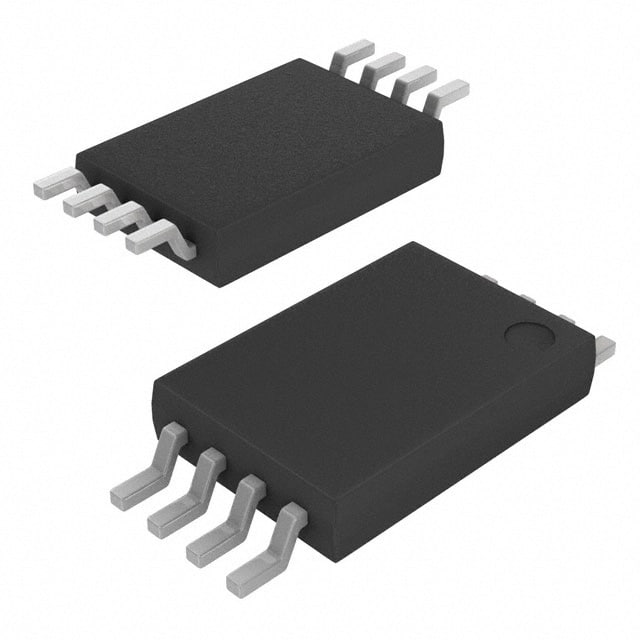TPS2115PWRG4
Product Overview
Category
The TPS2115PWRG4 belongs to the category of integrated circuits (ICs) and specifically falls under the power management ICs.
Use
This IC is primarily used for power multiplexing applications, where it enables seamless switching between two power sources.
Characteristics
- Power multiplexer with low on-resistance
- Supports input voltages ranging from 2.7V to 5.5V
- Can handle continuous output currents up to 1.5A
- Low quiescent current consumption
- Fast switching speed for efficient power source selection
Package
The TPS2115PWRG4 comes in a small outline integrated circuit (SOIC) package. This package offers good thermal performance and ease of handling during assembly.
Essence
The essence of the TPS2115PWRG4 lies in its ability to intelligently manage power sources, ensuring uninterrupted power supply to the load.
Packaging/Quantity
The TPS2115PWRG4 is typically packaged in reels, containing 2500 units per reel.
Specifications
- Input Voltage Range: 2.7V to 5.5V
- Continuous Output Current: Up to 1.5A
- On-Resistance (RON): Typically 50mΩ
- Quiescent Current: Typically 10µA
- Operating Temperature Range: -40°C to +85°C
Detailed Pin Configuration
The TPS2115PWRG4 has a total of 16 pins, each serving a specific function. The pin configuration is as follows:
- EN (Enable)
- IN1 (Input 1)
- GND (Ground)
- IN2 (Input 2)
- VBAT (Battery Voltage)
- VOUT (Output Voltage)
- PGND (Power Ground)
- FLT (Fault Indicator)
- NC (No Connection)
- NC (No Connection)
- NC (No Connection)
- NC (No Connection)
- NC (No Connection)
- NC (No Connection)
- NC (No Connection)
- VIN (Input Voltage)
Functional Features
- Automatic power source selection based on input voltage levels
- Fast switching between power sources to ensure uninterrupted power supply
- Low on-resistance for minimal power loss
- Fault indicator for easy troubleshooting
- Wide input voltage range for compatibility with various power sources
Advantages and Disadvantages
Advantages
- Efficient power multiplexing for seamless power source switching
- Low power consumption in standby mode
- Compact package for space-constrained applications
- Wide operating temperature range for versatility
Disadvantages
- Limited output current capacity compared to some other power management ICs
- No built-in protection features against overvoltage or overcurrent conditions
Working Principles
The TPS2115PWRG4 operates by continuously monitoring the input voltages at IN1 and IN2 pins. Based on the detected voltage levels, it automatically selects the appropriate power source and connects it to the load through the VOUT pin. The enable pin (EN) can be used to control the power multiplexer manually.
Detailed Application Field Plans
The TPS2115PWRG4 finds application in various fields where power multiplexing is required. Some of the potential application areas include:
- Portable electronic devices: Enables seamless switching between battery and external power sources.
- Automotive systems: Facilitates power source selection between the vehicle's electrical system and an auxiliary power supply.
- Industrial equipment: Allows for efficient power management in systems with multiple power sources.
- IoT devices: Ensures uninterrupted power supply by intelligently switching between different power sources.
Detailed and Complete Alternative Models
- TPS2113PWRG4: Similar to TPS2115PWRG4, but with a lower continuous output current rating of 1A.
- TPS2117PWRG4: Offers higher continuous output current capacity of up to 2A, suitable for applications requiring higher power levels.
- TPS2118PWRG4: Provides additional built-in protection features against overvoltage and overcurrent conditions.
These alternative models offer similar functionality to the TPS2115PWRG4 but with varying specifications to cater to different application requirements.
Word count: 593 words
तकनीकी समाधानों में TPS2115PWRG4 के अनुप्रयोग से संबंधित 10 सामान्य प्रश्नों और उत्तरों की सूची बनाएं
Sure! Here are 10 common questions and answers related to the application of TPS2115PWRG4 in technical solutions:
Q: What is the TPS2115PWRG4? A: The TPS2115PWRG4 is a power multiplexer IC that allows seamless switching between two power sources.
Q: What are the typical applications of TPS2115PWRG4? A: TPS2115PWRG4 is commonly used in battery-powered systems, portable devices, and any application requiring power source redundancy.
Q: How does TPS2115PWRG4 achieve power source redundancy? A: TPS2115PWRG4 has two input pins for connecting two power sources, and it automatically switches between them based on their availability.
Q: What is the maximum voltage rating of TPS2115PWRG4? A: The maximum voltage rating of TPS2115PWRG4 is typically around 18V.
Q: Can TPS2115PWRG4 handle high current loads? A: Yes, TPS2115PWRG4 can handle current loads up to several amps, depending on the specific model.
Q: Does TPS2115PWRG4 require any external components for operation? A: Yes, TPS2115PWRG4 requires external capacitors and resistors for proper operation.
Q: Is TPS2115PWRG4 compatible with both analog and digital signals? A: Yes, TPS2115PWRG4 can handle both analog and digital signals without any issues.
Q: Can TPS2115PWRG4 be used in automotive applications? A: Yes, TPS2115PWRG4 is suitable for automotive applications as it can handle the required voltage and current levels.
Q: Does TPS2115PWRG4 have any built-in protection features? A: Yes, TPS2115PWRG4 has built-in overcurrent and thermal protection to safeguard against excessive current or temperature.
Q: Where can I find more information about TPS2115PWRG4's application and usage? A: You can refer to the datasheet provided by the manufacturer, which contains detailed information about the application and usage of TPS2115PWRG4.
Please note that the answers provided here are general and may vary depending on the specific requirements and use cases. It is always recommended to consult the datasheet and technical documentation for accurate and up-to-date information.


